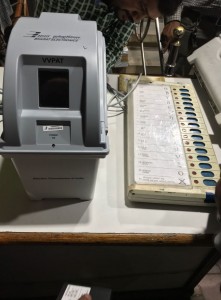The Election Commission of India (ECI) is a constitutional authority responsible for the conduction of free and fair elections in our country. Article 324 of the Constitution vests in the Election Commission the superintendence, direction and control of the preparation of the electoral rolls for, and the conduct of, all elections to Parliament and to the Legislature of every State and of elections to the offices of the President and Vice-President held under the Constitution. In a step towards protecting our democracy and universal adult franchise of all the citizens above the age of 18, the ECI has implemented the usage of Electronic Voting Machines (EVM) to help in making the electoral process faster and more secure.
History and advantages of the EVMs
The ides of EVMs was first proposed in the year 1977 by the ECI and a prototype was developed by 1979.
EVMs manufactured in 1989-90 were used on experimental basis for the first time in 16 Assembly Constituencies in the States of Madhya Pradesh (5), Rajasthan (5) and NCT of Delhi (6) at the General Elections to the respective Legislative Assemblies held in November, 1998. The most important advantage is that the printing of millions of ballot papers can be dispensed with, as only one ballot paper is required for fixing on the Balloting Unit at each polling station instead of one ballot paper for each individual elector. This results in huge savings by way of cost of paper, printing, transportation, storage and distribution. Secondly, counting is very quick and the result can be declared within 2 to 3 hours as compared to 30-40 hours, on an average, under the conventional system. Thirdly, there are no invalid votes under the system of voting under EVMs. The importance of this will be better appreciated, if it is remembered that in every General Election, the number of invalid votes is more than the winning margin between the winning candidate and the second candidate, in a number of constituencies and the number of instances of booth capturing has reduced significantly. To this extent, the choice of the electorate will be more correctly reflected when EVMs are used. EVMs can record a maximum of 3840 votes. As normally the total number of electors in a polling station will not exceed 1500, the capacity of EVMs is more than sufficient. [1] An Officer is put on duty to cover about 10 polling stations on the day of poll. He will be carrying spare EVMs and the malfunctioning or out-of-order EVM can be replaced with a new one. The votes recorded until the stage when the EVM went out of order will be safe in the memory of the Control Unit and it will be sufficient to proceed with the polling after the EVM went out of order. It is not necessary to start the poll from the beginning. [1] VVPAT – Voter Verifiable Paper Audit Trail In the recent controversy surrounding the EVM hacking, VVPAT is the middle ground between using the EVMs or Ballot Papers alone. It is a second line of verification that can be used in case of any voter fraud issues as it can verify that the vote polled by a voter goes to the correct candidate. [2] After a voter presses the button on the EVM against the chosen candidate, the VVPAT prints As per the direction of the Supreme Court of India, approval was received for purchase of 16,15,000 VVPATs at a cost of Rs. 2616.30 Crore for the 2017-18 and 2018-19. All required VVPATs will be procured by the Commission by September, 2018. Questions have been raised by several political parties on the usage of EVMs and their usage leading to skewed results in certain constituencies. These questions have been answered by the ECI in their Status Paper [3] There are several kinks in the system of electoral processes, but we must not forget that the ECI has been able conduct free and fair elections, protecting our democracy at all times. Whatever issues and suggestions one might have in this regard has to be brought to their notice and a suitable solution can be obtained, and not attack the very basis of our democracy with doubt and suspicion. Let us uphold our right to free and fair elections by participating in the upcoming elections and ensure we make our voices be heard. Your Vote Counts. Register.Vote.Participate. VVPAT awareness video: https://www.youtube.com/watch?v=xjdDrxooA6g&feature=youtu.be&list=PL-uM743Jsa0kEHaTDEU2bdOpLUuCHLN1M https://www.youtube.com/watch?v=Umt0N8mLdHs&index=3&list=PL-uM743Jsa0kEHaTDEU2bdOpLUuCHLN1M
a slip containing name of the candidate and the election symbol and drops it automatically
into a sealed box. The machines give the chance for the voter to verify their vote. The
machine is placed in a glass case in a way that only the voter can see it. The slip is displayed
to the voter for seven seconds after which the VVPAT machine cuts it and drops it into the
storage box with a beep. The machines can be accessed, only by the polling officials and
not by the voter, no mobile phones are allowed inside the polling station hence taking photo of VVPAT is prohibited during election.


![Electronic Voting Machine [EVM] and VVPAT [Voter Verifiable Paper Audit Trail]](https://bpac.in/wp-content/uploads/2018/04/Picture-4.jpg)



